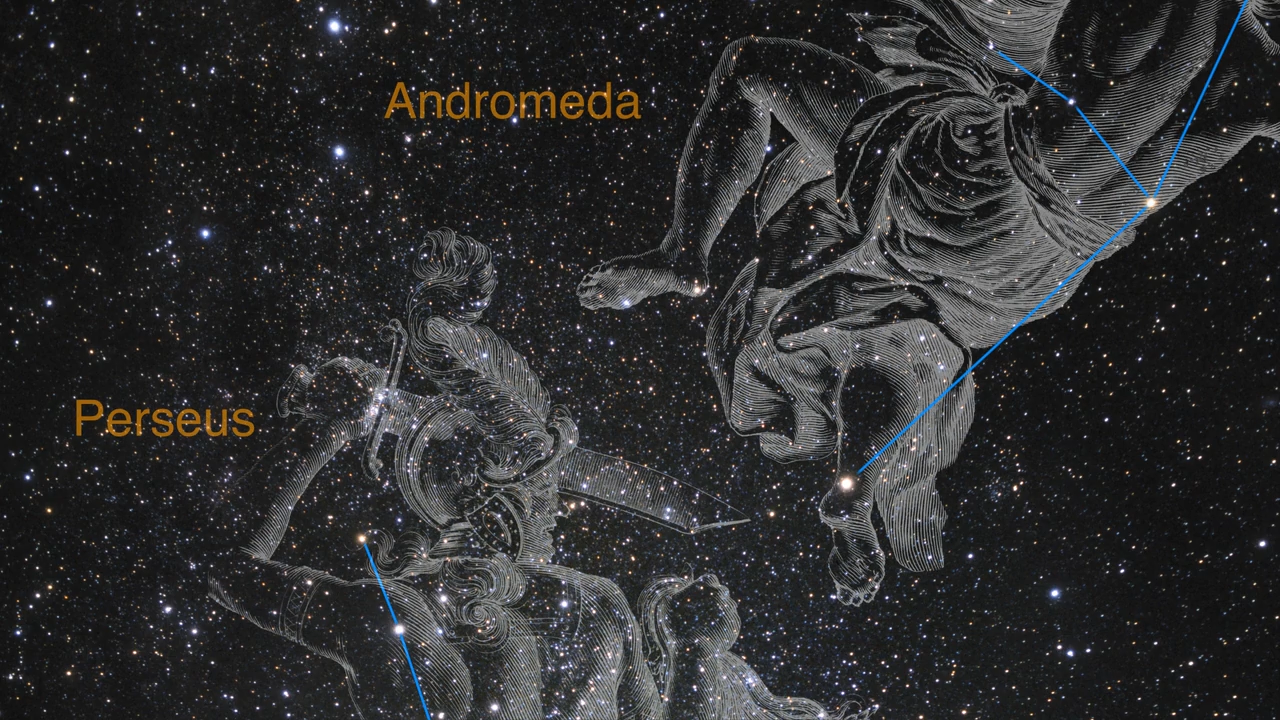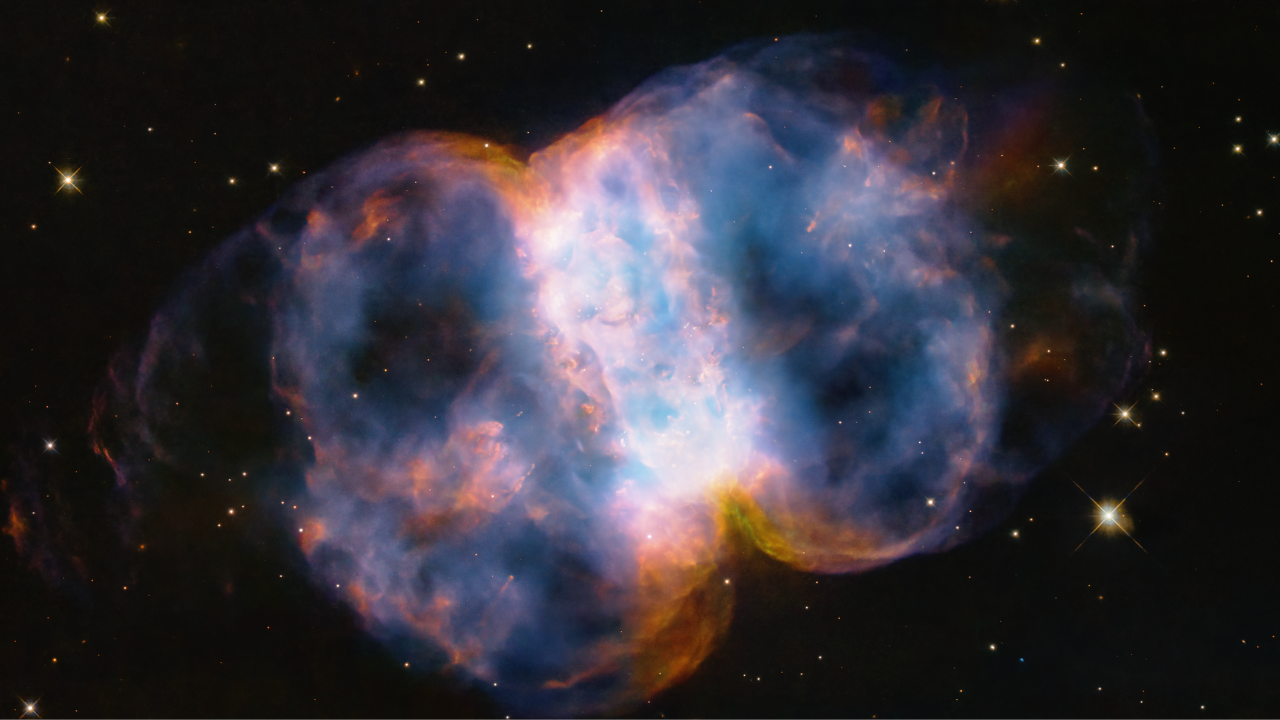1 min read
Little Dumbbell Nebula (WFC3 Image)

In celebration of the 34th anniversary of the launch of NASA’s legendary Hubble Space Telescope, astronomers took a snapshot of the Little Dumbbell Nebula, also known as Messier 76, or M76, located 3,400 light-years away in the northern circumpolar constellation Perseus. The name 'Little Dumbbell' comes from its shape that is a two-lobed structure of colorful, mottled, glowing gases resembling a balloon that’s been pinched around a middle waist. Like an inflating balloon, the lobes are expanding into space from a dying star seen as a white dot in the center. Blistering ultraviolet radiation from the super-hot star is causing the gases to glow. The red color is from nitrogen, and blue is from oxygen.
Extended Description and Image Alt Text
Extended Description
A rectangle of space with a black background scattered with gold-colored stars, some with four-point spikes. At the center, and taking up most of the image, is a nebula appearing as two translucent orbs attached by a white band. The orbs shine with blue, red, and orange cloud-like material, with some tendrils of fading colors floating away into space from the edges of both orbs, like loops of smoke. Where the two orbs are bonded, the red, blue, and orange colors are blocked by a thick semi-transparent white vertical structure.
Image Alt Text
Taking up most of the image, is a multi-colored nebula appearing as two translucent orbs attached by a white band.
About the Object
- R.A. PositionR.A. PositionRight ascension – analogous to longitude – is one component of an object's position.01:42:12
- Dec. PositionDec. PositionDeclination – analogous to latitude – is one component of an object's position.+51:34:56
- ConstellationConstellationOne of 88 recognized regions of the celestial sphere in which the object appears.Perseus
- DistanceDistanceThe physical distance from Earth to the astronomical object. Distances within our solar system are usually measured in Astronomical Units (AU). Distances between stars are usually measured in light-years. Interstellar distances can also be measured in parsecs.3,400 light-years
- DimensionsDimensionsThe physical size of the object or the apparent angle it subtends on the sky.Image is about 5 arcminutes across (about 5 light-years)
About the Data
- Data DescriptionData DescriptionProposal: A description of the observations, their scientific justification, and the links to the data available in the science archive.
Science Team: The astronomers who planned the observations and analyzed the data. "PI" refers to the Principal Investigator.The HST observations include those from program 17398 (C. Britt). Image Processing: Varun Bajaj (STScI), Alyssa Pagan (STScI)
- InstrumentInstrumentThe science instrument used to produce the data.WFC3/UVIS
- Exposure DatesExposure DatesThe date(s) that the telescope made its observations and the total exposure time.21 Jan - 23 Jan 2024
- FiltersFiltersThe camera filters that were used in the science observations.F475W, F502N, F656N, F658N, F814W
- Object NameObject NameA name or catalog number that astronomers use to identify an astronomical object.Little Dumbbell Nebula, M76
- Object DescriptionObject DescriptionThe type of astronomical object.Planetary Nebula
- Release DateApril 23, 2024
- Science ReleaseHubble Celebrates 34th Anniversary with a Look at the Little Dumbbell Nebula
- CreditNASA, ESA, STScI

These images are a composite of separate exposures acquired by the WFC3/UVIS instrument on the Hubble Space Telescope. Several filters were used to sample various wavelength ranges. The color results from assigning different hues (colors) to each monochromatic (grayscale) image associated with an individual filter. In this case, the assigned colors are: Cyan= F475W, Blue= F502N, Green= F656N, Red= F658N, Orange= F814W

Related Images & Videos

Little Dumbbell Nebula (WFC3 Compass Image)
This is an annotated Hubble Space Telescope image of the Little Dumbbell Nebula, located 3,400 light-years away in the northern circumpolar constellation Perseus. The object’s name comes from its shape that is a two-lobed structure of colorful, mottled, glowing gases resembling...

Zoom to the Little Dumbbell Nebula
A zoom into the constellation Perseus reveals the Hubble Space Telescope's view of the Little Dumbbell Nebula. Also known as Messier 76, M76, or NGC 650/651, it is composed of a ring, seen edge-on as the central bar structure, and two lobes on either opening of the ring. The two...

A Tour of Messier 76
In celebration of the 34th anniversary of the launch of NASA's legendary Hubble Space Telescope on April 24, 1990, astronomers took a snapshot of the Little Dumbbell Nebula. Also known as Messier 76, M76, or NGC 650/651, it is composed of a ring, seen edge-on as the central bar...
Share
Details
Claire Andreoli
NASA’s Goddard Space Flight Center
Greenbelt, Maryland
claire.andreoli@nasa.gov































